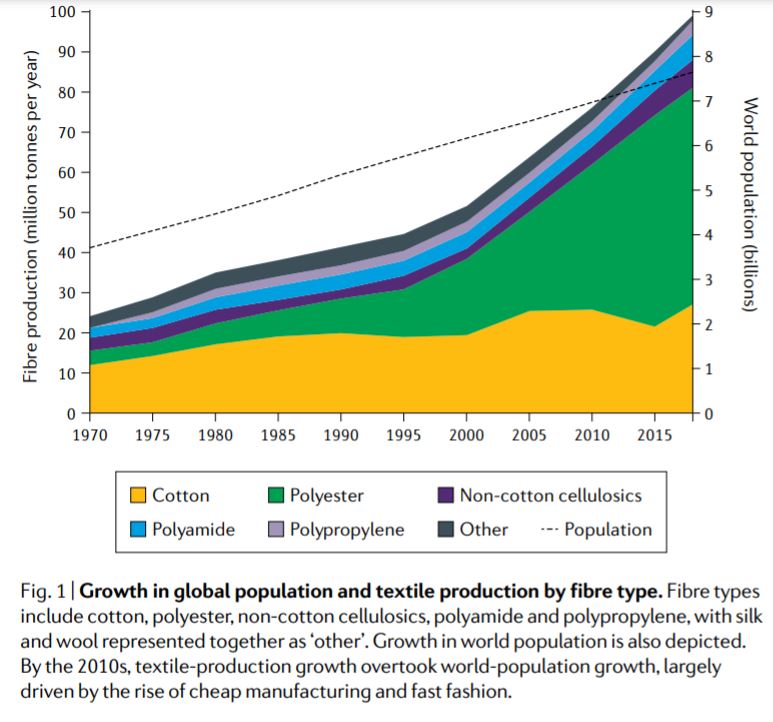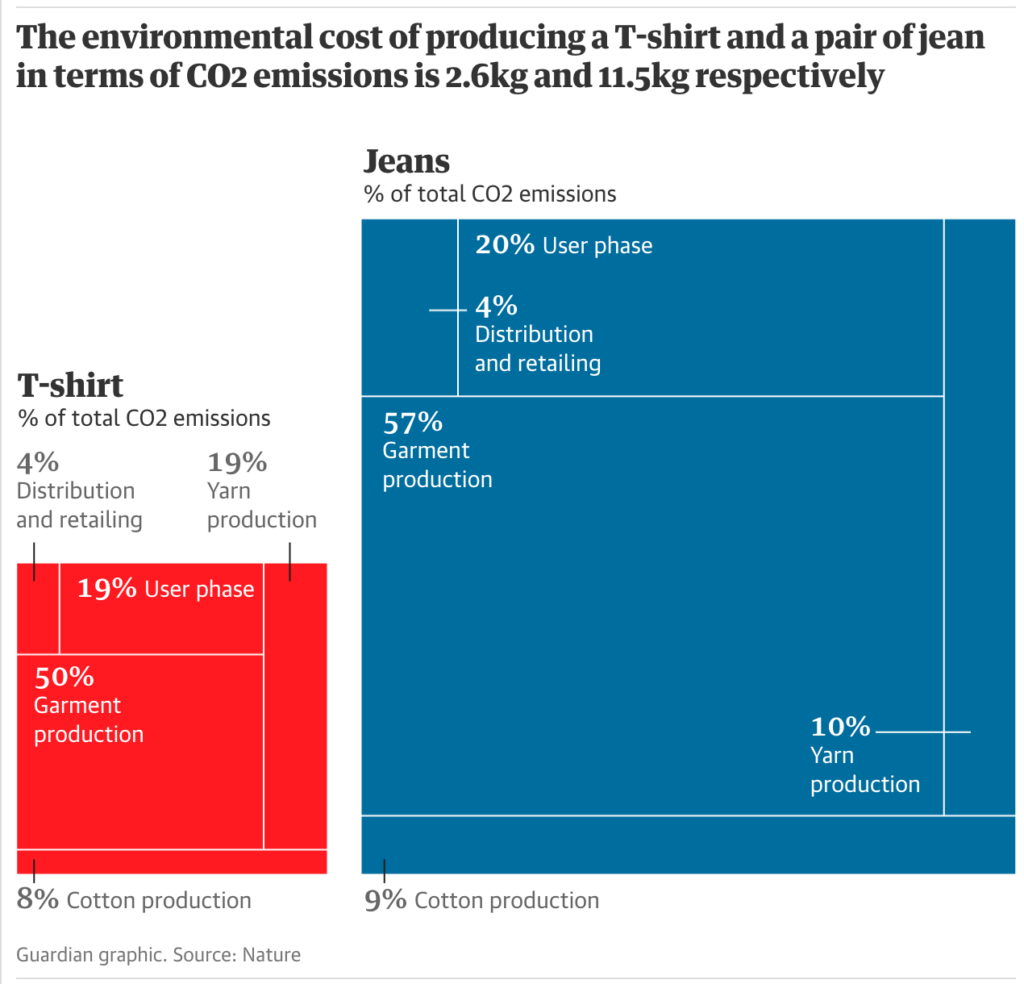The fashion industry, especially since the rise of fast fashion, is among the most damaging industries for the environment, responsible for 10% of global carbon emissions and 20% of global wastewater.
—
This article is based on a review article by Niinimaki et al. (2020), published in Nature in April 2020.
Some history
Up until the late 90s and early 00s, global fibre production was rising alongside population growth to accommodate a for more people, but in the past two decades the growth rate of fibre began to outpace population growth as individual global consumption of clothing increased. Niinimaki et al. (2020) point out that this dramatic rise in fibre production and fashion consumption coincides with the emergence and growth of fast fashion beginning at the turn of the millenium.

What is Fast Fashion?
Fast fashion refers to the large sector of the fashion industry w
hose business model relies on cheap and speedy production of low quality clothing which cycles in and out the market quickly to meet new trends. This system encourages excessive consumption as people are offered up cheap and trendy goods on a continuous basis in order to stay on trend. Rather than buying a few well made and long lasting items, consumers are pushed to continuously buy lots of cheap products which quickly fall out of fashion and get disregarded, and/or degrade after a few wears due to the cheap quality (Good On You). This model has been hugely profitable for retailers as customers are tricked into spending more through multiple smaller purchases. Furthermore, manufacturers cut production costs by using synthetic and chemically treated materials rather than organic ones in order to lower prices and encourage more consumption.
Environmental Impact of Fast Fashion
The increased production and consumption of fashion has serious and long lasting environmental impacts. As previously noted, fast fashion contributes an estimated 10% of global CO2 emissions annually.
The figure below shows the environmental impact of a pair of jeans and a t-shirt, broken down by the proportion of CO2 emitted in each phase of the garment’s life, from yarn and garment production, to transportation, to personal use (ie. washing), and finally disposal. The production phase, which involves growing and working raw materials into textiles and assembling them into garments, is most environmentally destructive. Half of the environmental costs associated with a T-shirt come from its production, and in jeans it’s more than half.

The production phase is so environmentally destructive due to the water and energy use, as well as chemicals involved in the process. In 2015 alone, 79 billion cubic meters of water was used by the fashion industry (Niinimaki et al. 2020). Regional water scarcity in manufacturing regions of Asia has been attributed to fast fashion due to the large quantity of material produced there. And through the use of harmful chemicals to lower production costs, fast fashion is linked to the contamination of local groundwater and negative impact surrounding ecosystems. The cost of production is therefore shifted away from manufacturers and onto local ecosystems.
Another environmental impact stems from the rise of synthetic, non-biodegradable materials such as polyester. They are energy intensive to produce and introduce more plastic into the world. Synthetic fibres have proliferated the fashion industry in recent decades as a cheap alternative to organic and natural resources at a cost to the surrounding environment. Produced through fossil fuels, synthetic materials do not decay, making effective disposal impossible and recycling difficult. Once disregarded they end up in landfills (or oceans) and will remain there for a very long time.
It is easy for consumers to remain unaware of these impacts because the environmental costs occur in the manufacturing and production countries, namely China, India, and Bangladesh, often far away from where they are purchased.
What Needs to Change?
Fundamental changes need to be made to the production and consumption models associated with fast fashion.
On the production end, we need to shift toward long lasting designs which are well made and easy to mend. High quality, organic, and sustainable materials need to be used. Hemp offers a sustainable alternative to other materials as it is biodegradable, does not require irrigation, and is not chemically treated. Another alternative is to recycle and reuse old materials in the production of new garments – this minimizes waste while enabling evolving fashion trends.
On the consumer end, people need to buy less, buy better, repair, and recycle. Nearly 3 in 5 garments ends up in landfills, oceans, or an incinerator within just one year of being produced. But good quality materials designed to last discourage excessive consumption and waste as there is not a constant need to buy and replace single items. When items do break they are often repairable and it is often worth investing in repairing it than buying new – like you would with a computer or phone.
People can also switch up how to consume fashion. Renting clothing can be especially useful for occasion clothing, such as party dresses and suits. Buying second hand and going to clothing swaps are both low cost ways of updating your wardrobe while producing minimal waste.
Looking forward: The Rise of Slow Fashion
The Slow Fashion Movement arose in response to fast fashion and promotes an awareness for the environment in the industry with ethical production, consumption, and disposal throughout the fashion industry. It campaigns for brands to produce versatile and durable items in an ethical way, and encourages people to purchase items thoughtfully and deliberately.
This article was written by Lola Robinson.
You might also like: Can Global Port Operations Withstand Climate Change?
Reference
-
Niinimäki, K., Peters, G., Dahlbo, H. et al. The environmental price of fast fashion. Nat Rev Earth Environ 1, 189–200 (2020). https://doi.org/10.1038/s43017-020-0039-9










![The Statistics of Biodiversity Loss [2020 WWF Report]](https://u4d2z7k9.rocketcdn.me/wp-content/uploads/2020/12/lprwinkyTHB-544x306.jpg)





